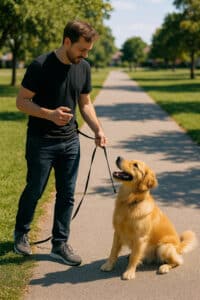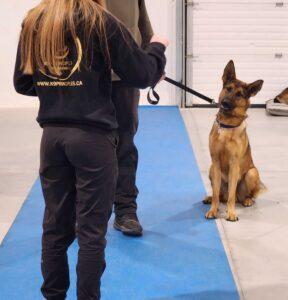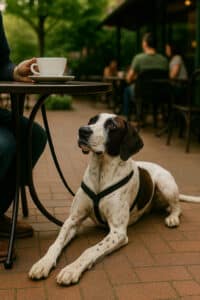When people talk about dog training in Hamilton, they often think of obedience—sit, stay, come, heel. But the truth is, none of those cues matter if your dog is too afraid, overstimulated, or under-socialised to function in the real world. Socialisation isn’t an optional add-on. It’s the very foundation of emotional stability, impulse control, and long-term behavioural success. And it starts far earlier than most new puppy owners realise. Without structured, well-timed socialisation, no amount of obedience training will fix the deeper insecurities a dog carries into adulthood. So if you’re raising a new puppy and you want to avoid future problems like fear aggression, reactivity, anxiety, or hypervigilance, you need to understand how socialisation really works, what it isn’t, and how to do it right. That’s what this guide is for.
Socialisation means helping your puppy learn how to safely and confidently navigate the world they’ll live in—not just tolerate it, but truly understand it. This includes exposure to people, animals, environments, sounds, objects, textures, and situations in a way that feels safe and manageable. It’s not just about quantity, and it’s certainly not just about “getting them used to stuff.” It’s about how your puppy emotionally processes new information. Many people think they’re socialising their puppy by bringing them to loud events, busy shops, or crowded dog parks—but what they’re actually doing is overwhelming them. Proper socialisation builds resilience. Flooding builds fear. There’s a world of difference between the two.
The Science Behind Early Learning: What’s Going On Inside That Puppy Brain
To understand why socialisation is so critical, you need to know what’s happening inside your puppy’s brain. Between the ages of roughly three to fourteen weeks, your puppy goes through what’s called a critical socialisation period. During this window, their brain is biologically primed to absorb information about the world—what’s safe, what’s dangerous, what’s familiar, and what’s novel. The experiences they have during this stage literally wire their emotional responses for life. If a puppy is gently and consistently exposed to a wide variety of people, places, sounds, and sensations, they learn that novelty is normal. If they aren’t? Their brain becomes wary of the unfamiliar. That’s how we get adult dogs who bark at bins, panic at fireworks, growl at visitors, or bolt from the vet’s office.
At K9 Principles, we see this every day in our work with families seeking Hamilton dog training. The difference between dogs who had thoughtful early exposure and dogs who didn’t is enormous. And while we absolutely help dogs overcome fear and insecurity later in life, nothing is more effective than prevention. That’s why our puppy programmes place such a heavy emphasis on socialisation—because getting it right now saves you years of undoing later.
Timing Is Everything: When Should Socialisation Begin?
So when should you start? Immediately. Many vets and breeders still advise waiting until your puppy is fully vaccinated before beginning any socialisation. But that advice is outdated and potentially damaging. Waiting until sixteen weeks means you’ve already missed the most important window. Now, to be clear—we’re not saying you should take your puppy to the dog park on day one. Safety matters. But there are countless safe, low-risk ways to begin socialisation before full vaccination. You can carry your puppy in public spaces. Invite healthy, dog-savvy friends over. Sit outside a busy café with them on your lap. Walk them through new rooms in your home with different lighting and textures. Play audio of traffic, thunderstorms, or children laughing at a low volume while you play or feed them. Every safe exposure builds their understanding of the world.
Avoiding the Trap of Overexposure: Flooding vs. Socialisation
But not all exposure is equal. This is where many owners unintentionally go wrong. If you throw your puppy into chaotic situations without support, that’s not socialisation—it’s flooding. Flooding happens when a dog is pushed past their emotional threshold and can no longer process or cope. Instead of learning that a situation is safe, they learn that the world is unpredictable and scary. And unfortunately, these negative experiences tend to stick. At K9 Principles, we help owners learn to read their puppy’s body language so they can spot overwhelm before it spirals. A confident puppy may lean forward, wag their tail loosely, and explore at their own pace. A stressed puppy may freeze, crouch, lick their lips repeatedly, yawn when not tired, tuck their tail, or show whale eye (when the whites of their eyes are visible). If you see any of those signs, it’s time to slow down. Socialisation should be about building micro-successes, not testing limits.
Building the Right Experiences: What Should Be Included in Socialisation?

So what should socialisation include? Think of it as building a mental library of experiences. Your puppy should meet people of all sizes, ages, races, and clothing styles—men with beards, children running, people using wheelchairs, people carrying umbrellas. They should see other animals, but always in a calm, controlled context—not chaotic group play. They should walk on different surfaces—tile, carpet, metal grates, grass, sand. They should hear loud sounds from a distance first—buses, sirens, hair dryers, vacuum cleaners—before gradually moving closer. They should experience handling in a positive way—paws touched, ears looked at, being lifted, gently restrained. All of this prepares them for the realities of everyday life. Without it, the world becomes unpredictable and overwhelming. With it, they learn to handle novelty with calm curiosity.
Local Context Matters: Socialising in Hamilton
If you live in Hamilton, you’ve got unique opportunities and challenges for puppy socialisation. Our city offers a wide range of environments—urban streets, suburban parks, bustling waterfronts, and quieter trails. At K9 Principles, we design socialisation plans that make use of Hamilton’s real-life settings. We take into account local weather, population density, common neighbourhood setups, and local dog culture. Whether it’s learning to stay calm near joggers on the Bayfront, navigating outdoor patios downtown, or getting used to strollers in Gage Park, we train for the world your dog will actually live in.

How K9 Principles Does Socialisation Differently
Our approach at K9 Principles is different because it’s tailored to each dog. Not every puppy is ready for the same thing at the same time. Some are bold and curious from day one. Others are more cautious or sensitive. We assess your dog’s temperament, confidence level, and learning style, then build a step-by-step plan that supports their emotional growth. We never use one-size-fits-all classes. Instead, we offer structured experiences that prioritise safety and success. We work with you to build calmness, trust, and a shared language that carries into adulthood. Our Puppy Starter package is the perfect training program to help set your puppy up for success. These are one-on-one private training sessions to ensure you have the utmost success with your puppy. That’s what sets us apart from typical dog training in Hamilton.

Mistakes That Undermine Socialisation—and How to Avoid Them
It’s also important to talk about what not to do. Many owners unintentionally derail their puppy’s social development by focusing on volume instead of quality. They think if they take their dog everywhere, they’re helping them. But random, unstructured exposure—especially to other dogs—is often more harm than help. Dog parks, in particular, are one of the worst places to socialise a puppy. There’s no control, no safety protocol, and no guarantee that the dogs there are healthy or well-mannered. One negative encounter—being chased, growled at, or overwhelmed—can have a lasting impact. Puppies are like wet cement during this stage. Every experience leaves an imprint.
Reading the Room: How to Respond to Fear or Overwhelm
Another mistake is misunderstanding how to respond when your puppy is afraid. Owners often make two common errors—either they try to soothe their puppy in a panicked tone, or they get frustrated and push the puppy forward. Neither response helps. What your puppy needs is calm leadership. A confident tone. Predictability. Gentle encouragement without pressure. You don’t need to cheerlead or baby them. You need to be their steady guide. At K9 Principles, we teach owners how to lead through calm consistency. Your body language, energy, and tone matter as much as the environment. If you’re relaxed, your puppy learns that they can be too.
Can You Fix Missed Socialisation? Yes—With the Right Approach
Now, what if your puppy missed that early socialisation window? Maybe you adopted them at sixteen weeks or older. Maybe life got in the way. Is all hope lost? Absolutely not. The path is different, but it’s still open. Older puppies and even adult dogs can learn to feel safe in the world—but it takes a slower, more deliberate approach. At K9 Principles, we specialise in helping late-start dogs. We rebuild social confidence using desensitisation, counter-conditioning, and gradual exposure. We show you how to pair new experiences with food, play, and praise so that your dog begins to associate novelty with safety. It takes time. It takes consistency. But it’s possible.
Emotional Regulation: The Real Gift of Early Socialisation
One of the most misunderstood aspects of socialisation is the emotional regulation it teaches. When a puppy is repeatedly exposed to low-level stressors that resolve positively, they learn how to manage arousal and settle themselves. This is one of the most valuable life skills a dog can learn. A socialised dog doesn’t just “get along” with others—they know how to stay calm, think clearly, and bounce back from minor stress. This emotional flexibility is what makes a dog truly trainable. And it’s why socialisation should always be step one in any Hamilton dog training program.
Our Commitment to You and Your Puppy
At K9 Principles, our Puppy Starter program includes detailed education for you, not just your dog. We teach you how to identify red flags, avoid common traps, and reinforce desirable behaviour in the moment. You’ll learn how to communicate clearly, advocate for your dog in public, and create positive experiences even in everyday routines. We help you navigate early fear periods, manage exposure timing, and maintain balance between stimulation and rest. This is training that transforms both ends of the lead.
Conclusion: Socialisation Isn’t Optional—It’s Everything
To sum it all up, puppy socialisation is not a side task—it’s the main event. It’s the lens through which your dog will view every other part of life. And it’s your responsibility to guide them through it with empathy, clarity, and consistency. Don’t leave it to chance. And don’t wait until problems show up to start. Let us help you set the tone from day one. At K9 Principles, we offer more than obedience—we offer understanding. And that’s what creates calm, stable, confident dogs for life. If you’re serious about giving your dog the best possible start with dog training in Hamilton, start with socialisation. Start with us.
Contact us for more information:
- Name: K9 Principles
- Address: Haldimand County, Greater Hamilton Area, Burlington, and Most of Norfolk County
- Phone: 289 880-3382
- Email: k9principlesinc@gmail.com
- Website: www.k9principles.ca
FAQs
-
A1. You’re not too late—but the path forward needs to be slower and more structured. We can help you rebuild confidence using gradual, safe exposure techniques that work with your dog’s emotional needs, not against them.






